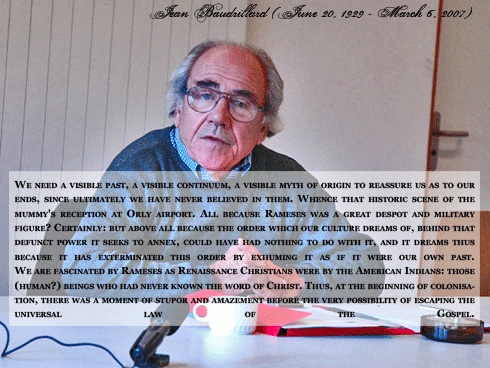
 sonn
sonn
son on facebook
son on twitter
sonn on tumblr
son on computerlove
 aa
aa
aa on vimeo
aa on facebook
aa on twitter
 sonn
sonn
 aa
aa
Mr. Jean Baudrillard (perhaps ...
Jean-Michel Basquiat was ...
Erwan Frotin, Flora Olbiens ...
CNN reports: "Grammy Award- ...
My favorite fashion brand is ...
{ 1 } Comments
We need a visible past, a visible continuum, a visible myth of origin to reassure us as to our ends, since ultimately we have never believed in them. Whence that historic scene of the mummy’s reception at Orly airport. All because Rameses was a great despot and military figure? Certainly: but above all because the order which our culture dreams of, behind that defunct power it seeks to annex, could have had nothing to do with it, and it dreams thus because it has exterminated this order by exhuming it as if it were our own past.
We are fascinated by Rameses as Renaissance Christians were by the American Indians: those (human?) beings who had never known the word of Christ. Thus, at the beginning of colonisation, there was a moment of stupor and amazement before the very possibility of escaping the universal law of the Gospel. There were two possible responses: either to admit that this law was not universal, or to exterminate the Indians so as to remove the evidence. In general, it was enough to convert them, or even simply to discover them, to ensure their slow extermination.
Thus it would have been enough to exhume Rameses to ensure his extermination by museumification. For mummies do not decay because of worms: they die from being transplanted from, a prolonged symbolic order, which is master over death and putrescence, on to an order of history, science and museums – our own, which is no longer master over anything, since it only knows how to condemn its predecessors to death and putrescence and their subsequent resuscitation by science. An irreparable violence towards all secrets, the violence of a civilisation without secrets. The hatred by an entire civilisation for its own foundations.
And just as with ethnology playing at surrendering its object the better to establish itself in its pure form, so museumification is only one more turn in the spiral of artificiality. Witness the cloister of St-Michel de Cuxa, which is going to be repatriated at great expense from the Cloisters in New York to be reinstalled on “its original site”. And everyone is supposed to applaud this restitution (as with the “experimental campaign to win back the sidewalks” on the Champs-Elysees!). However, if the exportation of the cornices was in effect an arbitrary act, and if the Cloisters of New York are really an artificial mosaic of all cultures (according to a logic of the capitalist centralisation of value), then reimportation to the original location is even more artificial: it is a total simulacrum that links up with “reality” by a complete circumvolution.
The cloister should have stayed in New York in its simulated environment, which at least would have fooled no one. Repatriation is only a supplementary subterfuge, in order to make out as though nothing had happened and to indulge in a retrospective hallucination.
In the same way Americans flatter themselves they brought the number of Indians back to what it was before their conquest. Everything is obliterated only to begin again. They even flatter themselves they went one better, by surpassing the original figure. This is presented as proof of the superiority of civilisation: it produces more Indians than they were capable of themselves. By a sinister mockery, this overproduction is yet again a way of destroying them: for Indian culture, like all tribal culture, rests on the limitation of the group and prohibiting any of its “unrestricted” growth, as can be seen in the case of Ishi. Demographic “promotion”, therefore, is just one more step towards symbolic extermination.
We too live in a universe everywhere strangely similar to the original – here things are duplicated by their own scenario. But this double does not mean, as in folklore, the imminence of death – they are already purged of death, and are even better than in life; more smiling, more authentic, in light of their model, like the faces in funeral parlors.